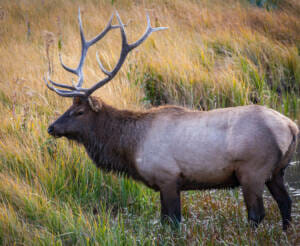
Young Bull Moose
Photographing wildlife can be challenging to say the least, especially if you want images of wildlife in their natural environment. One can usually find a zoo or game farm where there are great photographic opportunities. But is it the same? I have seen game farms where animals are actually posed for you. Of course there is a price for that depending on the number of animals and poses. However there is something special about finding an animal in their natural and wild environment, and catching them in a natural pose without enticement.
I often photograph in Yellowstone National Park and I suspect someone could say that the images in Yellowstone are really not animals in their natural environment. I strongly disagree with that thought, especially when I recount the hours and hours of patiently waiting for the animal to just appear, let alone strike a pose worthy of photographing. I have spent countless hours searching for “the perfect shot” only to be disappointed by my subject not cooperating. The worst part of shooting in Yellowstone is when other visitors discover you shooting and have to come right up to you so they can have a similar opportunity. And of course, those folks seem to lack the courtesy of being totally quiet. Too often there is way too much talking, activity and noise, and the animal soon realizes that the area they are in is “not for them”. They move away.

Bull Elk in Meadow
And then there is the amateur photographer who just has to get closer. Nine out of ten times they will either make the animal uncomfortable causing the animal to move away, or worse they place themselves in a dangerous situation where someone has to correct that “unprofessional behavior.” Again, that type of behavior ruins the opportunity for a possible great photograph, It is essential for any photographer to demonstrate deep respect for the wildlife they are photographing, and they must ensure that their photographing is not adversely effecting an animal’s natural environment or making that animal uncomfortable.. Good wildlife photographers will do whatever it takes to ensure the animal remains undisturbed and their environment remains as it should.
Photographing wildlife requires patience, respect for the animal, respect for the environment, and of course respect for other photographers.